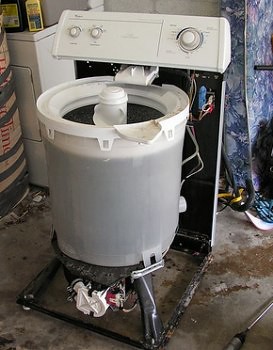Home-Tech: Washers & Dryers-1
Part of the reason I've been posting so infrequently is that my wife and I just moved to a new house, and in our neighborhood, DSL is not available. So we took over three weeks getting cable access. Now we're shopping for a washer and dryer, which has to be cheap: we didn't exercise options on Exxon-Mobile stock recently, and so we're tight on the money.
We live a few miles away from a Sears, a Lowes, and an Appliance Recycling Outlet. I checked out the Lowes page on what to look for in a clothes washer and a clothes dryer. Let's discuss the advice page there for a moment.
Clothes Washer:
The big item of discussion is whether to get a toploader or front loader. Unfortunately for us, the frontloaders are all very expensive, but I have to confess I regret that. First, my intuition is that frontloaders are traditionally what you use in a coin-op laundromat. That means they're tough, and also that they use less energy. Part of the reason is the spin cycle: in a top loader, the tub that spins acts as a centrifuge, and dries the clothing by spinning so fast that the water is pulled out into the holes in the tub. But woe betide if you load it improperly, or if you have a single heavy object, or something that happens to absorb a lot of water. In fact, even when I've lived places where I had access to a washer, I would take camping gear or large coats to laundromats for just that reason. There's no skin required to loading a front-loader, and it can take heavy objects.
It is also more energy efficient. In fact, arguing the merits of front-loading washers is like shooting fish in a barrel. The only flaw is that they typically start at about $450 or more. In contrast, a top loader can be found starting at about $200.

photo courtesy of Zenzoidman.
Tubs
Our previous washer ate socks. The socks would slip up into the rim of the tub and get wedged there. So I now pay special attention to the gap between the tub and the edge of the loading door. However, there is also a hierarchy of tub material: porcelin-lined metal (at the bottom—chips and rusts), then plastic, then stainless steel.
Water Levels, etc
The guide is not terribly helpful after that because it merely lists features and why they exist. Water level control is a feature, for example, found in nearly all machines; it allows one to select the load size. Digital controls have been introduced to save money fro the manufacturer, not you; vendors include programming, which I find irritating and silly. What if you have kids? Assuming you have the technical aptitude to program your washer and drier, will everyone in the household be able to master it too? Will this mean only children above the age of fifteen will be able to do their own laundry (contrary to popular belief, it is not true that all children somehow have a knack for electronic gear; the majority do not). And why would you want to program a washer anyway? So your load is finishing when you get back from running an errand?
Energy StarTM
Energy star labels mean the appliance complies with certain design parameters developed by the EPA. I've observed that a majority of devices for sale don't carry this label, so I'm guessing that it definitely means something.



0 Comments:
Post a Comment
<< Home